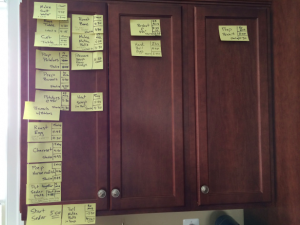Last week my wife and I hosted a Passover Seder. We have entertained together a number of times, but this was the first real attempt at a coordinated, sit-down meal. Most of our gatherings have been buffets, and less dependent on timing.We knew getting the timing of the Seder right would be a challenge. The meal is served in the middle of the Seder, not just when the guests arrive. We also knew there would be a lot of uncertainty. Potatoes don’t always cook the way you want them to, and guests never arrive all together. It would be difficult to plan everything perfectly. However, we knew we would both feel a lot more comfortable if there was a plan, to help keep us on the same page when we started making adjustments… and we always have to make adjustments.The night before the Seder, we went through all the things we’d have to do. We’d used Kanban-style visualization techniques before (to pack for trips and track jobs around the house), and there are three cabinets in our kitchen that work great as Ready, Doing, and Done lanes. So at first I started listing out each major task on a sticky note, but I quickly felt this would be inadequate.Time was an essential component of everything we had to do. We couldn’t just pull tasks when we were ready. The brisket had to cook for hours; potatoes had to be peeled and seasoned before going in the oven; matzo balls had to chill before going in the water to boil; and different things had to be ready at different times, paced to the rhythm of the Seder. Coordinating the timing of each task was one of the main reasons for our planning exercise.The solution we used was to write the time required for each task on the upper right of the sticky note. This allowed us to get a good picture of the overall flow. Working backward from the end, we started to determine when we wanted each task to complete. We also recorded that information on the sticky notes. Finally, through a little quick subtraction, we determined the times we needed each task to start, and put that on the sticky notes. We tried to keep our number of concurrent tasks low—thus limiting our work in progress—by staggering tasks where we could. Once this was done, we had a plan. We went to bed, comfortable and confident.The next morning, things started to go awry. The Seder’s co-host, who was expected to arrive early to help with the preparations, had a family emergency and couldn’t come. This was a significant problem. The plan had assumed she would be there. She was also bringing the Haggadah, so my wife started looking for alternatives online, a task we hadn’t anticipated, and one that took a long time to complete.The brisket pan turned out to be too large for the meat and its sauce. At some point, all the sauce cooked down and started to burn. We caught it in time, but reworking the brisket dish in the middle of the other preparations was an emergency we hadn’t counted on.But our visualizations were resilient. We were able to absorb these unforeseen issues into our plan without disrupting our overall flow. One reason for this was the slack we’d built in the night before. We had arranged the plan to keep the number of concurrent tasks low. This helped. The act of planning had also allowed us to see what needed to happen at specific times and what could be flexed. To make up for the time and hands we’d lost, we started pulling flexible tasks ahead when we had a little slack. Having the start time on each task made it easy to identify what to do next; when either one of us came free, we could grab it and get started. The visualization also allowed us to talk about what we were doing and where we were with it. We didn’t have to waste time talking about what to do next and could quickly help each other when necessary. The Kanban was our shared view of our work, an effective distributed form of cognition.The final result was a fun Seder, an excellent meal, and nearly perfect timing, in spite of the inevitable hiccups. Our Kanban Seder was wonderful, and I’m looking forward to doing it again next year.Follow me on Twitter.

